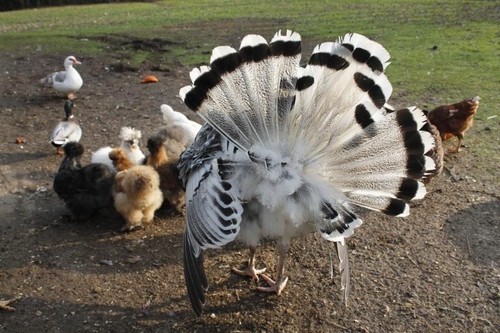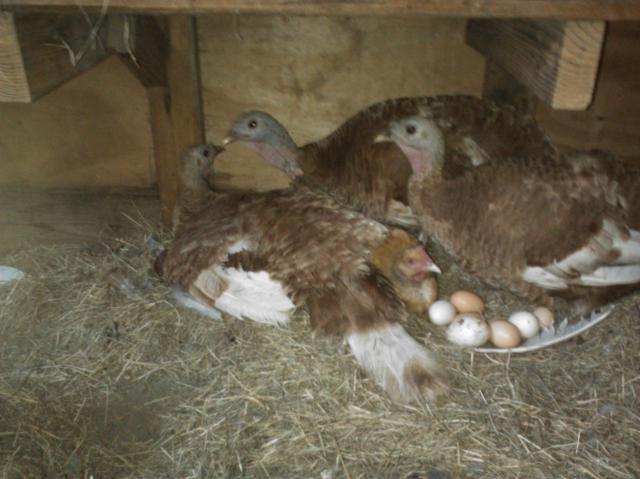Turkey is the largest poultry of all farmed on homesteads. But unfortunately, despite the rapid weight gain, summer residents do not breed it too often. The whole point is the prevailing opinion about the complexity of caring for this creature. Meanwhile, growing turkeys in the country is actually quite simple. The main thing is to first familiarize yourself with the rules for caring for this bird.
How to choose a breed
Almost everything grown on private courtyards of turkey is rapidly gaining weight. Breeding any breeds, therefore, is considered to be quite profitable. However, most often summer residents contain turkeys:
- Bronze North Caucasian. The males of these birds can reach a weight of up to 14 kg, and the females - up to 7 kg. Oviposition begins at ten months of age, and its duration is about 6 months per year. For all the time, one turkey can bring up to 80 eggs.
- White broad-chested. Turkeys of this breed can reach a weight of 17 kg, and turkeys - 7 kg. For a year, one female lays up to 120 eggs.
- Bronze broad-chested. The weight of males of this breed reaches 20-25 kg, and the egg production is about 90 pcs. in year.
These three breeds of turkeys are considered the most productive and hardy.
What should be a house
To keep turkeys, you can choose almost any barn. The main thing is that it is dry, warm enough and well lit. The floors of the room should be located at a distance of about 25 cm from the ground. Make them the best of boards. On cold concrete, the bird will freeze and catch a cold.
Whatever breeds of turkeys are kept on the farm, laying a floor with a thick layer of sawdust or straw is a mandatory procedure. In order to reduce the likelihood of infectious diseases, this litter should be changed at least twice a year. This is best done in the fall and spring. Before laying hay or straw, the floors should be sprinkled with slaked lime.
On 3 m2 of the house area there should not be more than two turkeys. Windows are usually arranged on the south or south-west side. It is also advisable to hang several fluorescent lamps in the house. However, this must be done carefully. 14 hours of winter lighting in a warm barn can cause egg laying.

Feeding troughs and nests
In order for turkeys to be grown on a private farm successfully, the house should, of course, be properly equipped. You can take any turkey feeders. No special requirements are imposed on their design. Very good, for example, chicken. The only thing is that the sides of the container under the feed should not be lower than the chest of the bird. Otherwise, turkeys will sprinkle food. Therefore, chicken feeders will either have to be placed on stands or suspended.
The same goes for drinkers. They are better to install higher. You can use, for example, a small table. The bird will jump on it and drink. In this way, pieces of litter and litter can be released into the water.
Jacks in turkey turkey are usually made with batteries. That is, 2-8 pieces are installed on top of each other. 4-5 turkeys should have one nest. Install batteries in the darkest place of the barn.

Perches for turkeys are made of thick poles and placed at a height of about 80 cm.
Most breeds of turkeys easily tolerate even the most severe frosts. However, to ensure that in winter the air temperature in the house does not drop below 5 degrees is still worth it. To do this, use a very thick litter.In summer, the most comfortable air temperature in the barn is 22 degrees.
A special area should be fenced next to the house. Walking is what turkeys especially need. Breeding this bird will be successful only if the site is large enough (the same as for geese). It is best to plant a walk with alfalfa or clover.
Turkey Growing Complex
In the second year of breeding in the compound, most likely, two generations of the bird will be kept. In this case, the barn will need to be expanded, thereby turning it into a mini-complex. The fact is that turkeys of different ages do not get along with each other and should be kept separately.
The large house can be simply partitioned with a netting net. The same should be done with walking.

Specialists also advise the separation of young males and females. However, most owners of private farmsteads do not see any particular need for this. If the turkeys grew up in the same herd, they probably will not fight even at the sight of turkeys.
Breeding Features
If the owners want to not only grow, but also breed turkeys on their own, for example, using an incubator, one male should be left for 8-10 females.
Turkey eggs begin to incubate around March - April. Moms, these birds are very good. Hatching instinct is well developed in most breeds. Many owners of private farms even lay eggs of hens, ducks and other poultry under turkeys.
In the first days of incubation, the turkey should be removed from the nest from time to time and brought to the drinker and feeder.
Breeding turkeys at home, as you see, is a procedure that has some of its own characteristics, but not too complicated. Keep turkeys away from another bird. Their character is quite aggressive, and their weight and strength are great.
Buying turkey poults
If the owners decided to start breeding turkeys for the first time, they will have to buy young animals, of course. The best place to acquire chicks is considered a poultry farm. Turkey at large enterprises is grown obviously thoroughbred and using a specially developed technique.
If there is no poultry farm nearby, chicks can also be purchased at the market. In any case, when buying turkey poultry, you should pay attention primarily to their appearance. The ass of the chicks should be dry and the fluff clean. You also need to look at the wings. They should be pressed tightly to the body. Another sign of a healthy chick is a taut belly.
When buying, it is also worth knocking on the wall of the box in which the poultry is sitting. Chicks must run to the sound. Such behavior indicates well-developed reflexes and vitality.
You need to transport purchased turkey poultry in a closed box made of cardboard in the passenger compartment.

Egg incubation
Thus, we figured out how to buy turkey chicks. Breeding this bird, however, can also be done through fertilized eggs. Of course, only if the farm has the appropriate equipment.
Incubation of turkey eggs lasts 28 days. The conditions that should be created for the proper development of the embryos can be found in the table.
| Incubation day | Humidity | Temperature | Ventilation | Turn |
| 1-6 | 56% | 37.8 gr. | - | 4 times a day |
| 7-12 | 52% | 37.5 gr. | 1 time per day 5 minutes | |
| 13-26 | 37.2 gr. | 2 times a day for 20 minutes | ||
| 27-28 | 70% | 37 gr | 1 time per day for 10 minutes | - |
Feeding turkey
Before reaching the age of 9 weeks, the chicks need to create special conditions. Feed during this period should be used only the highest quality. You also need to carefully monitor the air temperature in the house. The room is prepared in approximately the same way as for chickens.
The same goes for a procedure such as feeding turkey poults. Eating and drinking chicks hatched in an incubator will have to be taught on their own.In order for the young instinct to peck, the finger should be tapped on the plate with curd or crumbled eggs poured on it. The turkeys are taught to drink by carefully lowering their beaks into the drinker.
In addition to eggs and cottage cheese, chicks can be given yogurt and finely chopped greens. Well, of course, you need to feed them millet. Water small turkeys heated up to 24 degrees.
From the tenth day of life, you can begin to give ground cracklings, bones and boiled offal. Whole grains are included in the diet of young animals on the 7th week of life. From the age of nine weeks, you can include in the diet home feed. At the same time, chicks usually begin to walk.
How to feed an adult bird
The diet of grown turkeys consists mainly of dry grain and wet mash. Millet is given in the morning and in the evening. In the afternoon, the bird is fed a mixture of chopped grass with a small amount of bran. A stirrer is placed in the feeders and left there for the whole day.

Feather trim
This procedure with adult turkeys is a must. The fact is that they are very good flyers. You need to trim the fly wings and only on one side. This procedure is quite complicated, and therefore experienced houses usually advise beginners for the first time to invite a veterinarian to perform it. In the future, you just need to repeat his actions.

How profitable to breed
Of course, all the subtleties of keeping turkeys in one small article cannot be considered. However, we still hope that the information presented above at least helps someone to conclude whether it is worth keeping such a bird as a turkey on its yard. The price of her meat is very high. Of course, all the housewives know about this. So in any case, breeding turkeys can be considered quite profitable. However, you will still have to fulfill several important conditions for successful cultivation. Of course, it will be necessary to build a spacious barn, fence a walk, make or purchase feeders and drinking bowls, etc.
In many ways, the profitability of a home turkey farm also depends on how much grain costs in a particular area. So it’s up to you to decide whether or not to get such a bird as a turkey, breeding of which is a technologically simple task, but quite troublesome, only to the owners of the farmstead.









